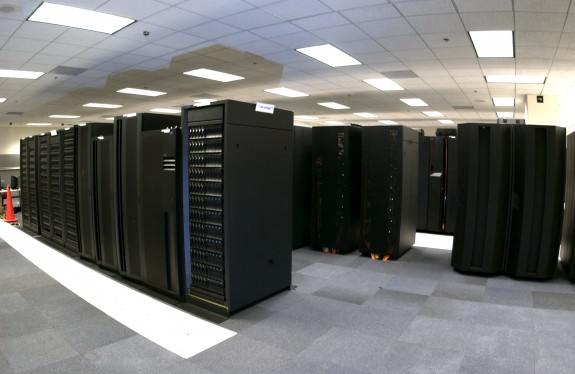Why We May Not See the Next Sandy Coming
Failing weather satellites will reduce our ability to forecast and track future storms

Supercomputers operated by the National Oceanic and Atmospheric Administration help to forecast the path and strength of hurricanes. Photo: NOAA
The damage from Hurricane Sandy was bad—water everywhere, homes, cars, subways flooded, trees down, buildings ripped apart, and dozens of people killed. But the devastation was surely minimized by the advance warning that gave people time such that supplies could be bought, low-lying areas could be evacuated and hatches could be battened.
That warning, the lead time that gave people a chance to get ready, stemmed directly from the hurricane track computer models operated by the National Weather Service, NASA, the Navy and others. Those models pull together measurements of air and sea surface temperature, pressure, wind speed, wind direction and more, then crunch through it all on some of the most powerful computers in existence. The result: as best a picture of the future weather as we can fathom.
The future usefulness of those models, however, is uncertain. The data that drive them come largely from measurements collected by satellites, and as Time reports, those satellites are dying.
On September 23, says Time, one of the key satellites watching over the eastern U.S., known as GOES-East, blinked out. A back-up was brought online, but things were still hairy.
Happily for the vulnerable northeast, NASA and NOAA had a back-up GOES parked in orbit nearby, and swung it into position while the engineers troubleshot the problems with the main ship. But that understudy was the last line of defense. If the back-up went offline as well, America’s entire weather forecasting web would have been struck partly blind. And that near-miss, a growing number of worried scientists believe, was an early glimpse of what could be our future.
According to The New York Times,
Experts have grown increasingly alarmed in the past two years because the existing polar satellites are nearing or beyond their life expectancies, and the launch of the next replacement, known as J.P.S.S.-1, has slipped to 2017, probably too late to avoid a coverage gap of at least a year.
This problem has been a long time coming. Last year, Climate Wire’s Lauren Morello quoted Jane Lubchenco, the head of the National Oceanic and Atmospheric Administration, as saying:
“Because we have insufficient funds in the ’11 budget, we are likely looking at a period of time a few years down the road where we will not be able to do the severe storm warnings and long-term weather forecasts that people have come to expect today.”
With broken satellites comes less data flowing into the weather models. And, from that, stems less certainty about the future, and less ability to plan for it.
More from Smithsonian.com:
Tropical Storm Sandy Could Bring Extreme Weather to the East Coast for Halloween
Tracking the Twists and Turns of Hurricanes
/https://tf-cmsv2-smithsonianmag-media.s3.amazonaws.com/accounts/headshot/smartnews-colin-schultz-240.jpg)
/https://tf-cmsv2-smithsonianmag-media.s3.amazonaws.com/accounts/headshot/smartnews-colin-schultz-240.jpg)